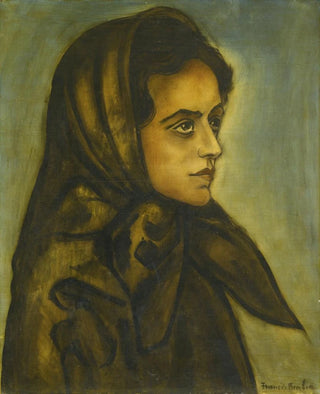Art print | Portrait of a woman - Francis Picabia


View from behind

Frame (optional)
Portrait of a woman - Francis Picabia – Captivating introduction
The "Portrait of a woman" by Francis Picabia is a work that transcends the simple boundaries of traditional portraiture to delve into a universe where abstraction and representation coexist with striking boldness. Created in the early 20th century, this iconic piece of the Dada movement invites viewers to a profound reflection on feminine identity, sensuality, and modernity. In this work, Picabia does not merely depict a woman; he captures an essence, an atmosphere that still resonates today. Through a palette of vibrant colors and bold shapes, he manages to evoke a palpable emotion, making this portrait a true masterpiece of modern art.
Style and uniqueness of the work
Picabia's style in "Portrait of a woman" is distinguished by its ability to blend abstraction and figuration, creating a fascinating visual tension. The woman's features are sketched with a lightness reminiscent of fluid lines in drawings, while the use of vivid and contrasting colors echoes the futurist and cubist movements of his time. This stylistic choice is not limited to a simple aesthetic representation; it is an exploration of subjectivity and perception. Each brushstroke seems charged with meaning, inviting the viewer to decipher the emotions and thoughts hidden behind the woman's face. This innovative approach places Picabia at the crossroads between the past and the future, tradition and avant-garde.
The artist and his influence
Francis Picabia, a major figure of the Dada movement, knew how to mark his time with his bold vision of art. His artistic journey is marked by encounters and experiments that shaped his unique style. By integrating elements of popular culture and references to science and technology, Picabia paved the way for new forms of artistic expression. His influence is felt not only within the Dadaist circle but also in the development of contemporary art. Through works like the "Portrait of a woman," he challenged artistic conventions of his era, inviting artists to explore uncharted territories. His legacy

Matte finish

View from behind

Frame (optional)
Portrait of a woman - Francis Picabia – Captivating introduction
The "Portrait of a woman" by Francis Picabia is a work that transcends the simple boundaries of traditional portraiture to delve into a universe where abstraction and representation coexist with striking boldness. Created in the early 20th century, this iconic piece of the Dada movement invites viewers to a profound reflection on feminine identity, sensuality, and modernity. In this work, Picabia does not merely depict a woman; he captures an essence, an atmosphere that still resonates today. Through a palette of vibrant colors and bold shapes, he manages to evoke a palpable emotion, making this portrait a true masterpiece of modern art.
Style and uniqueness of the work
Picabia's style in "Portrait of a woman" is distinguished by its ability to blend abstraction and figuration, creating a fascinating visual tension. The woman's features are sketched with a lightness reminiscent of fluid lines in drawings, while the use of vivid and contrasting colors echoes the futurist and cubist movements of his time. This stylistic choice is not limited to a simple aesthetic representation; it is an exploration of subjectivity and perception. Each brushstroke seems charged with meaning, inviting the viewer to decipher the emotions and thoughts hidden behind the woman's face. This innovative approach places Picabia at the crossroads between the past and the future, tradition and avant-garde.
The artist and his influence
Francis Picabia, a major figure of the Dada movement, knew how to mark his time with his bold vision of art. His artistic journey is marked by encounters and experiments that shaped his unique style. By integrating elements of popular culture and references to science and technology, Picabia paved the way for new forms of artistic expression. His influence is felt not only within the Dadaist circle but also in the development of contemporary art. Through works like the "Portrait of a woman," he challenged artistic conventions of his era, inviting artists to explore uncharted territories. His legacy






